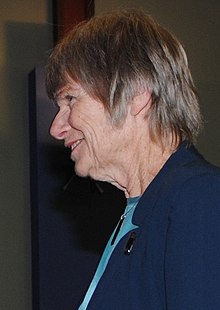| Christine WinterbourneCNZM FRSNZ | |
|---|---|
 Winterbourn in 2012 Winterbourn in 2012 | |
| Alma mater | Massey University |
| Known for | Research in biological chemistry of free radicals, first female recipient of the Rutherford Medal |
| Awards | Rutherford Medal, Marsden Medal |
| Scientific career | |
| Fields | Biochemistry |
| Institutions | University of Otago, Christchurch |
| Thesis | Lipid metabolism of mammalian erythrocytes with special reference to cellular aging (1968) |
| Doctoral advisor | Dick Batt |
Christine Coe Winterbourn CNZM FRSNZ is a New Zealand biochemist. She is a professor of pathology at the University of Otago, Christchurch. Her research in the biological chemistry of free radicals earned her the 2011 Rutherford Medal and the Marsden Medal, the top awards from each of New Zealand's two top science bodies.
Education
Winterbourn studied chemistry at the University of Auckland, followed by a PhD in biochemistry at Massey University. Her PhD thesis was an investigation of the lipid metabolism of mammalian erythrocytes, exploring changes in the lipid profiles in these cells as a function of the cells' age. She did postdoctoral work at the University of British Columbia, Canada. Her career since then has been spent at the University of Otago, Christchurch, where she has a chair in the Pathology Department.
Work
Winterbourn took a position at the University of Otago's Christchurch medical school in 1970. She set up her own laboratory in 1979/80, which grew into the Centre for Free Radical Research.
Her work explores the fundamental biochemistry of free radicals, which can have both beneficial and harmful effects in the body. She was one of the first scientists to demonstrate that human cells produce free radicals as part of their normal function. At low levels, they are essential to life, and contribute to the body's defences against infection, as well as playing a critical role in intracellular signalling. At higher levels, they can lead to oxidative stress, which has been implicated in a wide range of human diseases. Winterbourne did early work to document some of the chemical reactions of free radicals that occur in diseases such as cancer, stroke, coronary heart disease and arthritis.
Honours
Winterbourne was the first female recipient of the Rutherford Medal and in 1988 was elected a Fellow of the Royal Society Te Apārangi. In the 1997 Queen's Birthday Honours, Winterbourn was appointed an Officer of the New Zealand Order of Merit, for services to medical research. She was promoted to Companion of the New Zealand Order of Merit in the 2012 Queen's Birthday and Diamond Jubilee Honours, for services to science. In 2017, Winterbourn was selected as one of the Royal Society Te Apārangi's "150 women in 150 words", celebrating the contributions of women to knowledge in New Zealand.
References
- ^ "Free radical researcher Professor Christine Winterbourn wins New Zealand's top science and technology honour, the Rutherford Medal". royalsociety.org.nz. 2011. Archived from the original on 28 November 2011. Retrieved 25 November 2011.
Free radical researcher Professor Christine Winterbourn wins New Zealand's top science and technology honour, the Rutherford Medal
- "Professor Christine Winterbourn Awarded 2011 Rutherford Medal". stuff.co.nz. 2011. Retrieved 25 November 2011.
Christchurch biochemist and ground-breaking free radical researcher Professor Christine Winterbourn is the first woman scientist to be awarded New Zealand's top science and technology honour in its 20-year history.
- ^ "Professor Christine Winterbourn". nrcgd.org.nz. 2011. Archived from the original on 20 November 2011. Retrieved 25 November 2011.
- Winterbourn, Christine Coe (1968). Lipid metabolism of mammalian erythrocytes with special reference to cellular aging. Theses and Dissertations (Thesis). Massey University. Retrieved 13 December 2020.
- "About the Centre for Free Radical Research". University of Otago. Retrieved 13 December 2020.
- Priestley, Rebecca (26 November 2011). "Christine Winterbourn interview". www.noted.co.nz. Archived from the original on 21 April 2020. Retrieved 9 June 2020.
- Ancell, Simon (16 November 2011). "University of Otago researchers honoured in national awards". www.otago.ac.nz. Archived from the original on 20 September 2020. Retrieved 17 October 2018.
- Pham-Huy, Lien Ai; He, Hua; Pham-Huy, Chuong (June 2008). "Free Radicals, Antioxidants in Disease and Health". International Journal of Biomedical Science. 4 (2): 89–96. doi:10.59566/IJBS.2008.4089. PMC 3614697. PMID 23675073.
- "View our current Fellows". Royal Society Te Apārangi. Retrieved 21 November 2022.
- "Queen's Birthday honours list 1997". Department of the Prime Minister and Cabinet. 2 June 1997. Retrieved 16 July 2020.
- "Queen's Birthday and Diamond Jubilee honours list 2012". Department of the Prime Minister and Cabinet. 4 June 2012. Retrieved 16 July 2020.
- "Christine Winterbourn". Royal Society Te Apārangi. Retrieved 11 May 2021.
External links
- University of Otago Profile Archived 26 October 2020 at the Wayback Machine
- Christine Winterbourn. Interview on RNZ, 2011
| Recipients of the Rutherford Medal of the Royal Society of New Zealand | |
|---|---|
| New Zealand Science and Technology Gold Medal |
|
| Rutherford Medal |
|
- New Zealand pathologists
- New Zealand medical researchers
- Academic staff of the University of Otago
- People from Christchurch
- Living people
- Recipients of the Rutherford Medal
- Companions of the New Zealand Order of Merit
- Women biochemists
- Women pathologists
- New Zealand women scientists
- Fellows of the Royal Society of New Zealand
- Massey University alumni